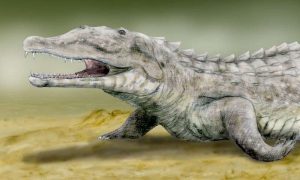
If I ask you to think of a large, extinct carnivorous reptile, what do you think of? I’m gonna guess that pretty much all of you went straight for a T. rex, or if you’re a bit weird (or vegetarian), maybe a Stegosaurus.
But if you think back in time of when the dinosaurs were around, and especially when they were just getting kick-started, there were so many other bizarre and spectacular groups of animals around.
Let’s go back to the Late Triassic, around 230 to 200 million years ago. Earth was pretty different to how it was now – you wouldn’t recognise any of the modern groups we know so well like birds, mammals, and amphibians. The continents were in disguise too, collaborating to form the giant supercontinent Pangaea, which sat over the equator ready to rupture at any second (slash million years or so…)
One of these groups were called phytosaurs, and are hideously under-appreciated beasts. They were a group of large carnivores, closely related to the earliest dinosaurs and crocodiles. It has often been pointed out that they even look suspiciously similar to some modern crocodylians, such as gharials, as both share elongated, tooth-filled snouts. This snout form is known as a ‘longirostrine’ morphology.
But beyond this superficial similarity, we actually know very little about crocodylians and phytosaurs.
Research by Stefan Lautenschlager and Richard Butler aimed to change this by investigating the resemblance between phytosaurs and crocodylians in terms of the structure of their brain cases, research that has only recently become possible due to the wider application of CT scanning technology.
This method allows us to scan the fragile skulls of fossils, and reconstruct them as digital 3D images. From here, we can explore and compare their anatomy in details that was not possible beforehand, and opens up a whole new realm of research possibilities for palaeontologists.
What they found is that phytosaurs have a very unusual and near-unique endocranial anatomy (the endocranium is the basal part of the skull that surrounds the brain). They have a really elongate olfactory tract, which means that they probably had super-reptilian senses of smell. The general structure of the brain architecture was also arranged as a series of longitudinal segments, a very distinct feature for phytosaurs.
Rather neatly though, it seems that modern crocodilians and their ancestors, collectively known as Crocodyliformes, share this general endocranial morphology. Modern crocodylians, including Crocodylus and Alligator are similar, as are other longirostrine and now extinct species including Pholidosaurus and Cricosaurus. Like phytosaurs, these extinct species would have spent all or most of their time out to sea.
Differences between the endocranial structures in phytosaurs can likely be explained by differences in their sensory evolution, related to adaptations to different modes of life and behaviours. For example, we might expect that phytosaurs that spend more time in water have greater sensory adaptations towards detecting movement of prey in lakes and rivers.
We’re only just beginning to understand the ecology and evolution of phytosaurs, and this study provides an exciting new step. By comparing them with crocodylians, we gain an additional dimension by being able to look at how similar living, breathing relatives behave. This is so important for developing our collective understanding and vision of phytosaurs not as fossils, but as animals that were once real and alive.
Reference:
Stephan Lautenschlager et al. Neural and endocranial anatomy of Triassic phytosaurian reptiles and convergence with fossil and modern crocodylians, PeerJ (2016). DOI: 10.7717/peerj.2251
Note: The above post is reprinted from materials provided by Public Library of Science.










